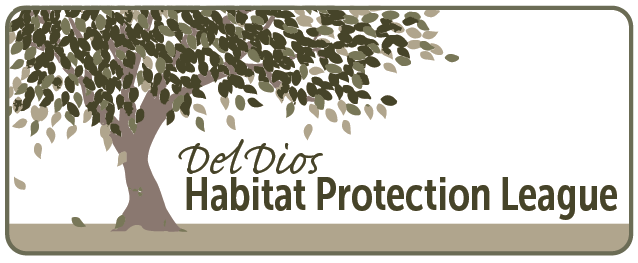GSOB Update
As most of you know GSOB is in its early stages in Del Dios and is already virulent in the Mt Israel valley. In Spring 2017 Brett Hutchinson meet with 40 residents in Mt Israel to show us bugs, canopy assessment, D shaped exit holes and a whole road show. The week before the Habitat Protection League hosted 85 people at a firehouse meeting with Dr. Tom Scott, UC Riverside, and Kevin Turner of Cal Fire.
Winter 2018: Most of our Oaks are suffering from drought stress from our hot summer and late rains. Oaks are tough and can handle many stressors that mother nature dishes out. What makes it hard are the extra things that humans add to the mix: grading, hardscapes, watering or planting schemes that may suit fungus more than oak tree roots, and non-native insects. Most stressor are slow acting. However, GSOB weakens the vascular system of these massive, life supporting living organisms and can kill a tree in a couple years.
You may see either Rob or Stacy McCline (and more volunteers - come help us!) poking around Del Dios collecting data about our oak trees. This accurate, eyes on the tree on data is one of the Best Management Practices used to treat GSOB conservatively and effectively. Our GSOB treatment plan focuses on spraying the trunk and thick branches of the oaks before adult beetles emerge. We are scheduling treatment in mid April.
A meeting with Plant Care Specialist, Ricardo Agular, is scheduled for March 21st at 6 PM in Del Dios Park. You'll have the opportunity to ask questions, learn about the signs of infestation and who to contact to have your trees effectively treated. Sign up for our newsletter or follow us on Facebook for updates to the meeting schedule.
Bring a Sample
We recommend bringing a sample of the bark or leaves from oak trees on your property that you think might be infested. Photos are also acceptable.
Can't attend the meeting? Email your photos and comments to Susan at smartdesi9n@gmail.com.
GSOB Facts
• Crown thinning, not dead branches, suggests GSOB infestation.
• An attacked oak won’t last long once it looks bad. Big trees usually die quickly.
• An oak can withstand GSOB attack for 1-15 years before dying. Factors include: health, drought, size, rot and level of insect attack.
• GSOB is spreading.
– By movement of infected firewood.
– Dispersal of beetles primarily within an oak canopy.
• There is no cure for GSOB.
– No biological control is being attempted. The natural predator is a parasitic wasp, but UCRiverside couldn’t get it to breed.
– Not an Agricultural threat so not much funding is available to study the pest.
• No existing template available for addressing conservation lands or ecologically significant woodlands. Best management practices are applied for each situation.
• Cal Fire grants are available to remove trees, not to save them.
One of our local residents, Diana Short, had her trees treated last year. Here's what she had to say about her experience.
"I have enjoyed learning about this beetle this year. It is not my favorite insect, for sure. To protect the oaks on "my" property we had a professional team visit and they gave us a topical spraying recommendation based on the size, age, and species of oaks. The cost was less than I had anticipated because I counted all the oaks, even the very young (less than 12" diameter), which are less at risk, apparently and didn't need treatment. Of the four trees sprayed, there is only one that is not doing so hot. Before spraying we identified the little black "D" s on the trunk and saw that it was not as verdant as others. It might make it- we hope for the best. This season I will be spraying early to hopefully thwart further damage. I am no expert, but when I'm out walking in the neighborhood I try to observe the general health of the local oaks. Most look good. I hope our oaks outlive this unwelcome beetle, and that this small act of tree care saves their lives."




